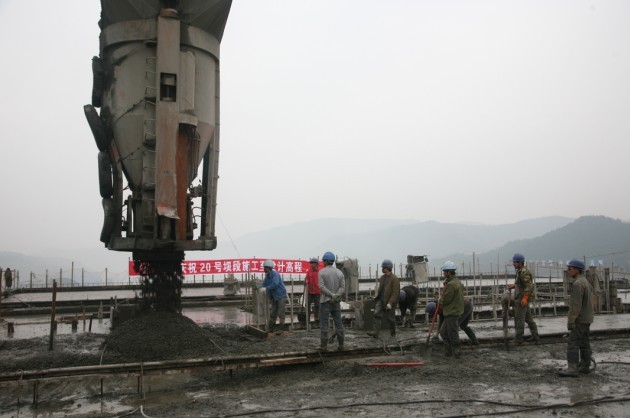
Accelerator is an admixture that hardens and congeals the concrete quickly. Accelerator includes main types such as inorganic salt and organic matters. Accelerator used in China belongs to organic salt. The organic salt accelerator is roughly classified into three types based on the main composition: sodium aluminate-based accelerator, calcium aluminate and calcium fluoraluminate-based accelerator; silicate(NaSiO
2)-based on accelerator. The main modelsinclude Red Start models 1, 711, 782, 8604, WJ-1 and J85 and so on.
1. Common accelerator. Red Start model 1 is a powder that is mixed according to ratio 1: 1:0.5 of aluminum oxygenchamotte (sodium aluminate is the main composition), sodium carbonate and quick lime. The appropriate mixing amount is 2.5%~4.0% of cement mass. Model 711 accelerator is mixed according to the mass ratio of 3:1 of aluminum oxygen chamottee and anhydrite and the appropriate mixing amount is 3%~5% of cement mass. Model 782 accelerator is mixed according to the mass ratio of r, 4.5%: 14.5%:11% of alum sludge, aluminum oxygenchamotte and quick lime and the appropriate mixing amount is 5%~7%. Other kinds of accelerators also regard the aluminum oxygen chamottee as the main composition. The accelerator can make concrete conduct initial setting within 5min and final setting within 10min after mixed into the concrete. After 1h, strength can be caused and the strength will be increased by 2~3 times after 1d. However, the later strength will be reduced and the strength is about 80%~90% of concrete without accelerator after 28d. The temperature is increased to improve the quick setting effect. If the water cement ratio of concrete is increased, the quick setting effect is reduced. Thus, the water cement ratio of concrete mixed with accelerator is about O.4. After the accelerator is mixed, the dry shrinkage rate of concrete may be toward increasing trend and the elasticity modulus, shear strength and cementing bond will be reduced.
2. Action mechanism of accelerator
After the accelerator is added into the concrete, the main composition, such as sodium aluminate and sodium carbonate, can react with gypsum in cement in alkaline solution rapidly and form the sodium sulfate. Thus, gypsum will lose the original delayed coagulation, calcium aluminate minerals are hydrated quickly and the hydration product crystal is separated out from the solution. Meanwhile, aluminum oxygen chamotte, lime and calcium sulfate in the accelerator will provide the effective composition for the calcium sulpho-aluminate hydrates and secondary gypsum crystal with small solubility. As a result, cement concrete will be coagulated quickly. The accelerator is mainly used for mine shaft, railway tunnel, water diversion culvert, underground project and sprayed concrete or sprayed mortar project for combined bolting and shotcrete. In order to improve spinner quality, save materials and improve working conditions in practical engineering, the accelerator and reducer are used together usually. (IV) Accelerator is an admixture thatlengthens the concrete setting time. Accelerator kinds include: hydroxyl carboxylic acid and salts, such as tartaric acid, citric acid, gluconic acid and salts and salicylic acid; sugary carbohydrates, such as molasses, glucose and saccharose; inorganic salts, such as borate, phosphate and zinc salt and so on; lignosulfonates, such as calcium lignosulphonate and nitroguaiacolsodium sault and so on.
1.Common retarder
(1) Molasses retarder
hexose sugar calcium and lime saccharate and so on. The general mixing amount is 0.1%~0.3% (powder) of cement mass and 0.2%~0.5% (water aqua). The concrete setting time can be lengthened for 2~4h. As 0.1% (water aqua) of mixing amount is increased, the setting time is lengthened for 1h. When the mixing amount is more than 1%, the concrete is loose for a long time; when the mixing amount is 4%, the strength after 28d is 1/10 of concrete without mixing amount.
(2) Hydroxy carboxylic acid and salt retarder
The mixing amount of such kind of retarder is 0.03%~0.10% of cement mass and the concrete setting time can be lengthened for 4~10h. The retarder can increase concrete bleeding rate and the bleeding rate is increased obviously for concrete with low cement content or larger cement water ratio. If it is used together with air-entraining agent, the above phenomenon will be improved.
(3) Ligno-sulfonic acid retarder
The mixing amount for this kind of retarder is 0.2%~0.3% of cement mass and the concrete setting time can be lengthened for 2~3h.
2. Action mechanism of retarder
The action mechanisms of all retarders are different. Generally speaking, most of organic retarders belong to surface active agents and have stronger active effect on cement particle and hydration product new phase surface. The organic retarder is attached to the solid particle surface to lengthen cement hydration and formation of paste structure. The inorganic retarder will form a layer of indissolvable film on the cement particle surface to shield the cement particle hydration and prevent cement normal hydration. The above actions will result in delayed coagulation of cement concrete. The adaption of retarder for cement type is obvious. Different cement types have different delayed coagulation effects, or even the opposite effect is appeared. Therefore, try to mix the cement before use to detect the effect. The mixing amount of retarder is little, thus, strictly control the mixing amount during use. Excessive mixing amount will result in non-setting for a long time or rapid hardening will be appeared sometimes. Retarder is mainly used for construction of concrete, mass concrete and pumping and slip form concrete construction and long-term transport in high temperature season. Retarder is not suitable for concrete constructionbelow 5℃ of daily minimum temperature or concrete and un-steamed concrete with requirements for early strength.
